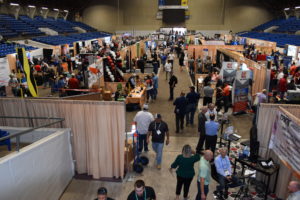
While the Coliseum floor is the best-known exhibit hall for PBIOS the show fills numerous buildings and encompasses many times as much space as is seen here.
ODESSA, TEXAS—The Oct. 19-21 run of the Permian Basin International Oil Show came off nicely for a show that had to bounce back from disappointment. There was the disappointment that came from having to call off the scheduled 2020 run of the event, due to Covid. And there has been the disappointment, felt across the whole industry, of having to press on against a political world that seems bent on defunding oil and gas.
Despite those headwinds, the oil and gas industry keeps making its way in the world. And the PBIOS event keeps providing a nexus where industry professionals can share their views, see the latest technology, and talk shop.
PBIOS is, by its own description, “a three-day gathering of producers, service companies, investors, and innovators, where ideas are exchanged, friendships are made, and deals are born.” Held biennially since the late 1940s, the show fills the Ector County Coliseum and the other exhibit halls and surrounding fairgrounds.
Understandably, this year’s iteration was less extravagant than the kinds of shows we saw at the height of the shale boom, some 7 or so years ago. Then, the occasion was over-the-top in grandeur, and filled to capacity with exhibitors. This year the difference was evident to the eye even before one found a parking place. The tall masts and towering booms, so numerous in shows from the past, were fewer and the parking and approach was less congested. But all in all, the show did justice to its theme of “Celebrate our History and Embrace our Future.” And the mood of exhibitors and attendees both was one of optimism. It didn’t hurt that commodity prices were at their highest levels of recent years.
PB Oil and Gas Magazine spoke with several individuals in attendance to get their impression not just of the show but of the times in which the industry finds itself.
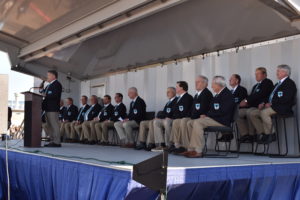
Larry Richards, at podium, delivers the opening address.
Larry Richards, executive chairman of VanZandt Controls LLC, a marketer of valve automation, flow measurement, and instrumentation, said that PBIOS is one of the best shows in the United States.
“The oil companies who are here are the ones who are putting new technology to work out in the field—doing work that’s never been done before—and they’re doing it on a monthly basis, and you get to see a lot of that at this show,” Richards said. “I’ve been fortunate enough to travel all over the world, and been in oilfields all over the world, and what you see in oilfields halfway around the world is stuff that we did in the Permian Basin five or ten years ago. This [show] is really on the tip of the spear, in terms of what is being done in some of the basins around here.”
As for the industry in general, and its current and future fortunes, Richards was philosophical.
“I get nervous about making any kind of prognosis, but I think that right now all the market fundamentals are really strong,” he said. “And it looks like we’ve got a really nice road ahead of us for the next several months, next several years. So I’m cautiously optimistic.”
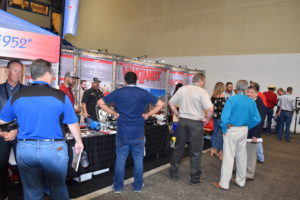
The VanZandt Controls booth was a happening place.
Richards said VanZandt has been “incredibly blessed with growth.”
“We’ve got a lot of customers that just continue to shower us with projects and work, and we’re out there trying to earn it every week. We’re building true partnerships with our customers, and that’s when it gets fun. You’re really a partner with them rather than a vendor. And we’ve evolved to that point. And that’s exciting. We’re laser focused on our niche. We’ve decided to stay in a narrow range, but have real expertise in that narrow range. And it’s been a good model for us.”
Chad Brown, owner of Legacy Flow Control, another exhibitor, also expressed optimism. “I think we’ve seen the worst of it,” Brown said from his booth in the main hall. “The oil price is going up. It’s a true supply shortage. I think the oil price is going to keep going up because of the demand. Whenever you get a Democratic President in office, the oil economy goes better. The rest of the economy goes down, but the oil market goes up.”
Asked why this trend, of oil improving during the administration of a White House that disfavors oil, would result, Brown admitted that it is counterintuitive. But when political policies hinder oil development, the supply of oil goes down, and prices, accordingly, go up. Which favors oil in the end.

Anything and everything is on display at PBIOS. Here, Celebrity magician Scott Wells performs card tricks and just generally cuts up at the booth of Legacy Flow Control. Scott is the father of Legacy’s Sean Wells. Yes, that is a stuffed African warthog standing there holding a tray that offers company literature.
Brown said that over the past year his company has been sought out more vigorously than usual for quotes on projects. “That tells me that the oil companies are putting their projects together. They’re monitoring the market. They want to make sure the demand’s going to be there. When the pandemic came, the oil price tanked, and investors took another look at their investments and realized they weren’t getting the return on investment they needed. So, that’s what’s taken so long for this turnaround to come, even though the oil price has already been going up. The oil companies are more focused on cleaning up their books and running cleaner and being more prudent on their investment decisions.
“And I think the investment market is starting to come back around and look at the oil market and they’re realizing, ‘We’re never going to get rid of oil.’ So, I think, this quarter, and all through 2022, is going to be good.”
Legacy Flow Control was enjoying its first year occupying a booth on the floor of the Coliseum. Brown said that his father had started, in 1981, a company called Flow Control Products and soon after had become exhibitors at PBIOS. Flow Control had a booth in Building G for something over 20 years. But eventually he achieved his wish of getting space in the Coliseum. When the elder Brown sold his company, son Chad had to sign a noncompete clause. But he satisfied the terms of the noncompete and now he is in the flow control business as well, with Legacy, his own company. And his current booth space is the same as that which was formerly occupied by his father, and Flow Control, in those many years past.
Stories like this, of how long a business has held a particular position in the show, are common.
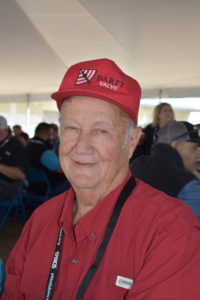
Joe Nelson, owner of Dartt Valve.
Joe Nelson, owner of Dartt Valve, is another everytime exhibitor. His product, a valve he designed himself, “allows the pump [on a plunger lift well] to operate like it was designed.”
“The big issue they have for the last 100 years is that gas interference causes the rods to stop. They stop because the valve doesn’t open. We open the valve every stroke and by doing that we eliminate the majority of the headaches with the plunger.”
Nelson said that at PBIOS he sells more valves to customers who are visiting the show from foreign countries than he sells to customers in the Basin. But then that’s part of the “International” that makes up “International Oil Show.”
All that being so, Nelson said he mainly comes to the Odessa event just to talk to people. Meanwhile, he said he is not happy with what the industry is feeling from the current occupants of the White House.
“They don’t have a clue what they’re doing,” Nelson said. “The last thing I’ll depend on is an electric car. There are benefits to them but can you imagine going to Buccee’s and having 300 people there trying to charge their car at one time? It [the electric car takeover] is not going to happen. I’d say it takes you 10 minutes to fill up a gas car now, but… then?”
He wasn’t finished. “And the part that bothers me most is, at least as I understand it, that our state allowed the Chinese to buy 130,000 acres in Texas and put windmills in. I’m a mechanical engineer, and as far as windmills are concerned, from what I know about them, the payout is 38 years and that doesn’t take into account maintenance. When the government quits subsidizing those things, then that’ll be the real price [of wind power]. As for solar, in order to put solar in you got to have a bank of batteries. You get electricity when there’s sunshine, and when there’s not sunshine you don’t. When they can fly a C-5A on batteries I’ll say, ‘Okay its time to go electric.’”
But are these good times for oil? Nelson isn’t fully convinced. “That’s a challenge. I can’t tell you,” he said. “The oil patch is hot and cold. Depending on how hot it is or how long it stays, this may last two months, it may last three months. We don’t know. Again, the way the White House is right now, it’s hard to judge.”
In Building D, the team from Plainville, Kansas-based Polymer Services met the public, shared their own story, and made contacts as well.
“And we’re trying to establish a yard here in Odessa,” said Randy Prater, company head. “And so we’re trying to build our Permian clientele and
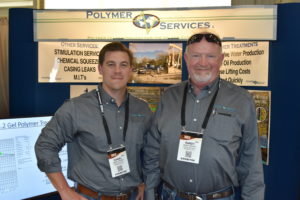
Daniel French and Randy Prater of Polymer Services
establish enough business. So far the show’s been helpful. We’re seeing a lot of different people. I think we’re in a good time for the industry because obviously oil prices are on a upward trend, or at least seem likely to maintain around $70, $80, for the next few years here. So, hopefully we can capitalize on that and get a permanent presence here in the Permian.”
A new twist for attendees and exhibitors alike was the introduction of a live “Podcast Party” right on the exhibition’s main floor. Jason Spiess, with The Crude Life broadcast, and Matt Hill, vice president of business development for Knight Fire Specialists, were the main hosts for the party. For his part, Hill said he was there to “interview people, find out what their company does, and find out how they got into oil and gas.”
Spiess was doing likewise. He said that they strive to tell energy’s story while taking the emotion out of the hydrocarbons-versus-renewables competition.
“We try to bring entertainment into the science, while so many out there are just sharing platitudes like ‘We’ve got to act now.’ Our slogan is ‘Renewables aren’t do-able without fossil fuel-ables.’ The idea there is that this green revolution cannot happen without fossil fuels, and so we’re trying to take emotion out of it, we’re trying to take attitude out of it. There’s a wrong attitude happening right now with climate change, global warming, global cooling, fossil fuels, all kinds of different things. The reality is that humans as a species have been decarbonizing for 150 years on their own. We started with hay and wood, and then we went to whales. I mean, for crying out loud, we almost made whales extinct.
“Then we went to coal, and then we went to crude oil, and now we’re at natural gas, so we started with, I don’t know, a hundred carbon [sources] and
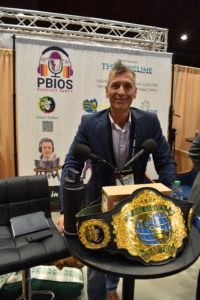
Jason Spiess of The Crude Life was one of the Podcast Party hosts.
now we’re down to one to four? The momentum was already happening and the innovation was happening long before the Sierra Club or Greta Thunberg came along. And that’s not a knock on the Sierra Club or Greta Thunberg. That is a knock on anyone who jumps on a movement that’s already happening. And the oil and gas industry and other energy has been taking care of the environment and staying ahead of it. I honestly think that we have a better quality of life because of the energy industry.”
They first used their slogan at an industry event in Brazil, where tension was strong because of political differences on the environment. “So when we said it, we got a laugh, but then the temperature in the room dropped by about 40 percent. Apparently we were controlling the climate in there, too.”
As for more local interests, Spiess said he and his team think the Permian has big days ahead in both its near and prolonged future. “I’ve had a lot to people more intelligent than me and make more money than me, that I also trust more than me, who’ve told me that 60 to 70 percent of the United States’ drilling is going to come out the Permian over the next 20 years,” he said.
That kind of enthusiasm, and more, was on hand for three days in Odessa. If the PBIOS event was any indication, Permian Basin oil and gas interests can look forward to having a “show” of their own, a showing of ever-improving economics and performance, in 2022 and beyond.









